Tree Mortality Following Mixed-Severity Prescribed Fire Dramatically Alters the Structure of a Developing Pinus taeda Forest on the Mid-Atlantic Coastal Plain
Abstract
:1. Introduction
2. Materials and Methods
2.1. Study Area
2.2. Prescribed Fire Treatment
2.3. Forest Inventory
2.4. Statistical Models
2.5. Remote Sensing
3. Results
3.1. Fire Effects on Forest Structure and Composition
3.2. Modeling Fire Effects on Plots and Trees
3.3. Remote Sensing of the Forest Canopy
4. Discussion
5. Conclusions
Author Contributions
Funding
Acknowledgments
Conflicts of Interest
References
- Hanberry, B.B.; Bragg, D.C.; Hutchinson, T.F. A reconceptualization of open oak and pine ecosystems of eastern North America using a forest structure spectrum. Ecosphere 2018, 9, 1–22. [Google Scholar] [CrossRef]
- Nowacki, G.J.; Abrams, M.D. The demise of fire and “mesophication” of forests in the Eastern United States. BioScience 2008, 58, 123–138. [Google Scholar] [CrossRef]
- Varner, J.M.; Gordon, D.R.; Putz, F.E.; Hiers, J.K. Restoring fire to long-unburned Pinus palustris ecosystems: novel fire effects and consequences for long-unburned ecosystems. Restor. Ecol. 2005, 13, 536–544. [Google Scholar] [CrossRef]
- Franklin, J.F.; Johnson, K.N.; Johnson, D.L. Ecological Forest Management; Waveland Press, Inc.: Long Grove, IL, USA, 2018; p. 646. [Google Scholar]
- Janowiak, M.K.; Swanston, C.W.; Nagel, L.M.; Brandt, L.A.; Butler, P.R.; Handler, S.D.; Shannon, P.D.; Iverson, L.R.; Matthews, S.N.; Prasad, A.; Peters, M.P. A practical approach for translating climate change adaptation principles into forest management actions. J. For. 2014, 112, 424–433. [Google Scholar] [CrossRef]
- Ryan, K.C.; Knapp, E.E.; Varner, J.M. Prescribed fire in North American forests and woodlands: history, current practice, and challenges. Front. Ecol. Environ. 2013, 11, e15–e24. [Google Scholar] [CrossRef]
- Livingston, A.C.; Varner, J.M.; Jules, E.S.; Kane, J.M.; Arguello, L.A. Prescribed fire and conifer removal promote positive understorey vegetation responses in oak woodlands. J. Appl. Ecol. 2016, 53, 1604–1612. [Google Scholar] [CrossRef]
- Van Lear, D.H. Recent advances in the silvicultural use of prescribed fire. In Fire and Forest Ecology: Innovative Silviculture & Vegetation Management; Moser, W.K., Moser, C.F., Eds.; Tall Timbers Research, Inc.: Tallahassee, FL, USA, 2002; pp. 183–189. [Google Scholar]
- Reilly, M.J.; Outcalt, K.; O’Brien, J.J.; Wade, D. Effects of repeated growing season prescribed fire on structure and composition of pine-hardwood forests in the Southeastern Piedmont, USA. Forests 2017, 8, 12. [Google Scholar] [CrossRef]
- Bond, M.L.; Siegel, R.B.; Hutto, R.L.; Saab, V.A.; Shunk, S.A. A new forest fire paradigm: The need for high-severity fires. Wildl. Prof. 2012, 46–49. [Google Scholar]
- DellaSala, D.A.; Hutto, R.L.; Hanson, C.T.; Bond, M.L. Accommodating mixed-severity fire to restore and maintain ecosystem integrity with a focus on the Sierra Nevada of California, USA. Fire Ecol. 2017, 13, 148–171. [Google Scholar] [CrossRef]
- Frost, C. Presettlement fire frequency regimes of the United States: a first approximation. In Fire in Ecosystem Management: Shifting the Paradigm from Suppression to Prescription; Pruden, T.L., Brennan, L.A., Eds.; Tall Timbers Fire Ecology Conference Proceedings. No. 20.; Tall Timbers Research Station: Tallahassee, FL, USA, 1998; pp. 70–81. [Google Scholar]
- Guyette, R.P.; Stambaugh, M.S.; Dey, D.C.; Muzika, R.M. Predicting fire frequency with chemistry and climate. Ecosystems 2012, 15, 322–335. [Google Scholar] [CrossRef]
- Landfire: Fire Regime Data Products (Percent of Mixed-Severity Fire). Available online: https://www.landfire.gov/pms.php (accessed on 7 May 2018).
- Stanturf, J.A.; Wade, D.D.; Waldrop, T.A.; Kennard, D.K.; Achtemeier, G.L. Fire in southern forest landscapes. In Southern Forest Resource Assessment; Wear, D.M., Greis, J., Eds.; USDA General Technical Report SRS-53; U.S. Dept. Ag, Forest Service, Southern Research Station: Asheville, NC, USA, 2002; pp. 607–630. [Google Scholar]
- Denny, C.S.; Owens, J.P. Sand dunes on the Central Delmarva Peninsula, Maryland and Delaware; Surface and shallow subsurface geologic studies in the emerged coastal plain of the Middle Atlantic States. Geological Survey professional paper 1067-C; U.S. Department of the Interior: Washington, DC, USA, 1979; p. 15.
- Newell, W.L.; Dejong, B.D. Cold-climate slope deposits and landscape modifications of the Mid-Atlantic Coastal Plain, Eastern USA. In Ice-Marginal and Periglacial Processes and Sediments; Martini, I.P., French, H.M., Alberti, A.P., Eds.; Special Publication 354; Geological Society: London, UK, 2011; pp. 259–276. [Google Scholar]
- Harrison, J.W. The Natural Communities of Maryland: 2016 Natural Community Classification Framework; Publication #03-662016-597; Maryland Department of Natural Resources, Wildlife and Heritage Service, Natural Heritage Program: Annapolis, MD, USA, 2016; pp. 1–35.
- NatureServe Explorer: An Online Encyclopedia of Life. Available online: http://www.natureserve.org/explorer (accessed on 15 July 2018).
- Grayson, L.M.; Progar, R.A.; Hood, S.M. Predicting post-fire tree mortality for 14 conifers in the Pacific Northwest, USA: model evaluation, development, and thresholds. For. Ecol. Manag. 2017, 399, 213–226. [Google Scholar] [CrossRef]
- Kobziar, L.; Moghaddas, J.; Stephens, S.L. Tree mortality patterns following prescribed fires in a mixed conifer forest. Can. J. For. Res. 2006, 36, 3222–3238. [Google Scholar] [CrossRef]
- Lilieholm, R.J.; Hu, S.C. Effect of crown scorch on mortality and diameter growth of 19-year-old loblolly pine. South. J. Appl. For. 1987, 11, 209–211. [Google Scholar]
- Wade, D.D.; Johansen, R.W. Effects of Fire on Southern Pine: Observations and Recommendations; USDA General Technical Report SE-41; USDA Forest Service Southeastern Forest Experiment Station: Ashville, NC, USA, 1986; p. 14.
- Varner, J.M.; Hiers, J.K.; Ottmar, R.D.; Gordon, D.R.; Putz, F.E.; Wade, D.D. Overstory tree mortality resulting from reintroducing fire to long-unburned longleaf pine forests: the importance of duff moisture. Can. J. For. Res. 2007, 37, 1349–1358. [Google Scholar] [CrossRef]
- Keyser, T.L.; McDaniel, V.L.; Klein, R.N.; Drees, D.G.; Burton, J.A.; Forder, M.M. Short-term stem mortality of 10 deciduous broadleaved species following prescribed burning in upland forests of the Southern US. Int. J. Wildland Fire 2017, 27, 42–51. [Google Scholar] [CrossRef]
- McNab, W.H. An overcrowded loblolly pine stand thinned with fire. South. J. Appl. For. 1977, 1, 24–26. [Google Scholar]
- Wade, D.D. Thinning young loblolly pine stands with fire. Int. J. Wildland Fire 1993, 3, 169–178. [Google Scholar] [CrossRef]
- Waldrop, T.A.; Lloyd, F.T. Precommercial thinning a sapling-sized loblolly pine stand with fire. South. J. Appl. For. 1988, 12, 203–207. [Google Scholar]
- Hoff, V.; Rowell, E.; Teske, C.; Queen, L.; Wallace, T. Assessing the relationship between forest structure and fire severity on the North Rim of the Grand Canyon. Fire 2019, 2, 10. [Google Scholar] [CrossRef]
- Lydersen, J.M.; Collins, B.M.; Miller, J.D.; Fry, D.L. Relating fire-caused change in forest structure to remotely sensed estimates of fire severity. Fire Ecol. 2016, 12, 99–116. [Google Scholar] [CrossRef]
- Picotte, J.J.; Robertson, K.M. Validation of remote sensing of burn severity in south-eastern US ecosystems. Int. J. Wildland Fire 2011, 20, 453–464. [Google Scholar] [CrossRef]
- Lorber, J.; Thomas-Van Gundy, M.; Croy, S. Characterizing Effects of Prescribed Fire on Forest Canopy Cover in the George Washington and Jefferson National Forests; Research paper NRS-31; Department of Agriculture, Forest Service, Northern Research Station: Newtown Square, PA, USA, 2018; p. 30.
- Butler-Leopold, P.; Iverson, L.; Thompson III, F.; Brandt, L.; Handler, S.; Janowiak, M.; Shannon, D.; Swanston, C.; et al. Mid-Atlantic Forest Ecosystem Vulnerability Assessment and Synthesis: A Report from the Mid-Atlantic Climate Change Response Framework Project; USDA General Technical Report NRS-181; U.S. Department of Agriculture, Forest Service, Northern Research Station: Newtown Square, PA, USA, 2018.
- Clark, K.L.; Skowronski, N.; Renninger, H. Climate change and fire management in the mid-Atlantic region. For. Ecol. Manag. 2014, 327, 306–315. [Google Scholar] [CrossRef]
- Mitchell, R.J.; Liu, Y.; O’Brien, J.J.; Elliott, K.J.; Starr, G. Future climate and fire interactions in the southeastern region of the United States. For. Ecol. Manag. 2014, 327, 316–326. [Google Scholar] [CrossRef]
- Walton, L.; (Vision Forestry, Salisbury, MD, USA). Personal communication, 2011.
- Scott, J.H.; Burgan, R.E. Standard Fire Behavior Fuel Models: A Comprehensive Set for Use with Rothermel’s Surface Fire Spread Model; USDA General Technical Report RMRS-GTR-153; U.S. Department of Agriculture, Forest Service, Rocky Mountain Research Station: Fort Collins, CO, USA, 2005; p. 72.
- McElligott, K.M.; Bragg, D.C. Deriving biomass models for small-diameter loblolly pine on the Crossett Experimental Forest. J. Ark. Acad. Sci. 2013, 67, 94–102. [Google Scholar]
- Robertson, K.M.; Ostertag, T.E. Biomass equations for hardwood resprouts in fire-maintained pinelands in the Southeastern United States. South. J. Appl. For. 2009, 33, 121–128. [Google Scholar]
- Reineke, L.H. Perfecting a stand-density index for even-aged forests. J. Agric. Res. 1933, 46, 627–638. [Google Scholar]
- Cain, M.D. Height of stem-bark char underestimates flame length in prescribed burns. USDA For. Serv. Fire Manag. Notes 1984, 45, 17–21. [Google Scholar]
- Waldrop, T.A.; Van Lear, D.H. Effects of crown scorch on survival and growth of young loblolly pine. South. J. Appl. For. 1984, 8, 35–40. [Google Scholar]
- Brown, A.A.; Davis, K.P. Forest Fire Control and Use, 2nd ed.; McGraw-Hill Book Co.: New York, NY, USA, 1973; p. 686. [Google Scholar]
- Garcia-Gonzalo, J.; Marques, S.; Borges, J.G.; Botequim, B.; Oliveria, M.M.; Tomé, J.; Tomé, M. A three-step approach to post-fire mortality modelling in maritime pine (Pinus pinaster Ait) stands for enhanced forest planning in Portugal. Forestry 2011, 84, 197–206. [Google Scholar] [CrossRef] [Green Version]
- Oliver, C.D.; Larson, B.C. Forest Stand Dynamics; Wiley: Hoboken, NJ, USA, 1996; p. 544. [Google Scholar]
- Weise, D.R.; Wade, D.D.; Johansen, R.W. Survival and growth of young southern pine after simulated crown scorch. In Proceedings of the 10th Fire and Forest Meteorology Conference, Ottawa, ON, Canada, 17 April 1989; MacIver, D.C., Auld, H., Whitewood, R., Eds.; pp. 161–168. [Google Scholar]
- Keyser, C.E. Southern (SN) Variant Overview – Forest Vegetation Simulator; Internal Report; U.S. Department of Agriculture, Forest Service, Forest Management Service Center: Fort Collins, CO, USA, 2018; p. 80.
- Brewer, J.S. Natural canopy damage and the ecological restoration of fire-indicative groundcover vegetation in an oak-pine forest. Fire Ecol. 2016, 12, 105–126. [Google Scholar] [CrossRef]
- Wilson, K.G.; Barefoot, C.R.; Hart, J.L.; Schweitzer, C.J.; Dey, D.C. Temporal patterns of ground flora response to fire in thinned Pinus-Quercus stands. Can. J. For. Res. 2018, 48, 1–13. [Google Scholar] [CrossRef]
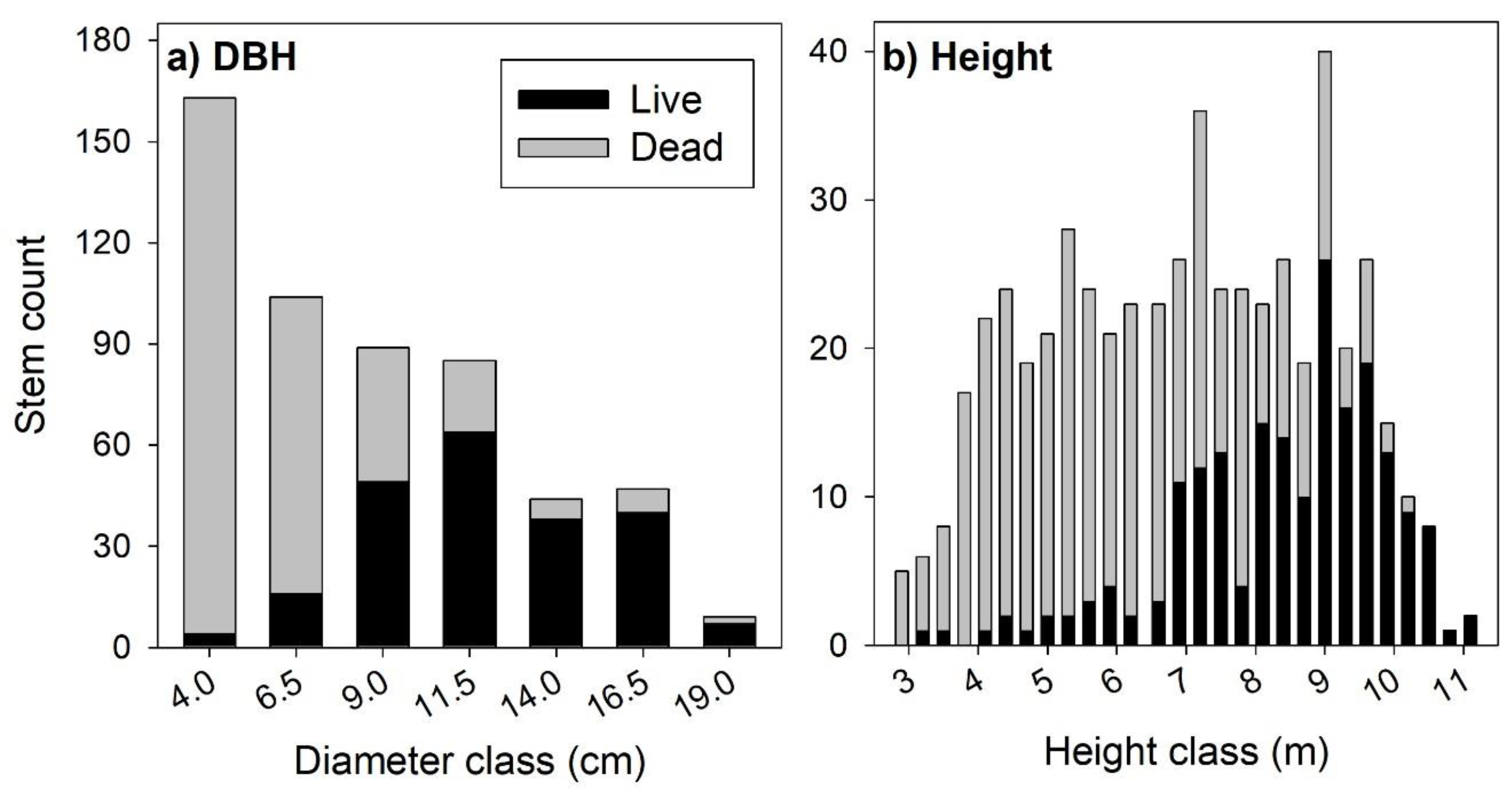
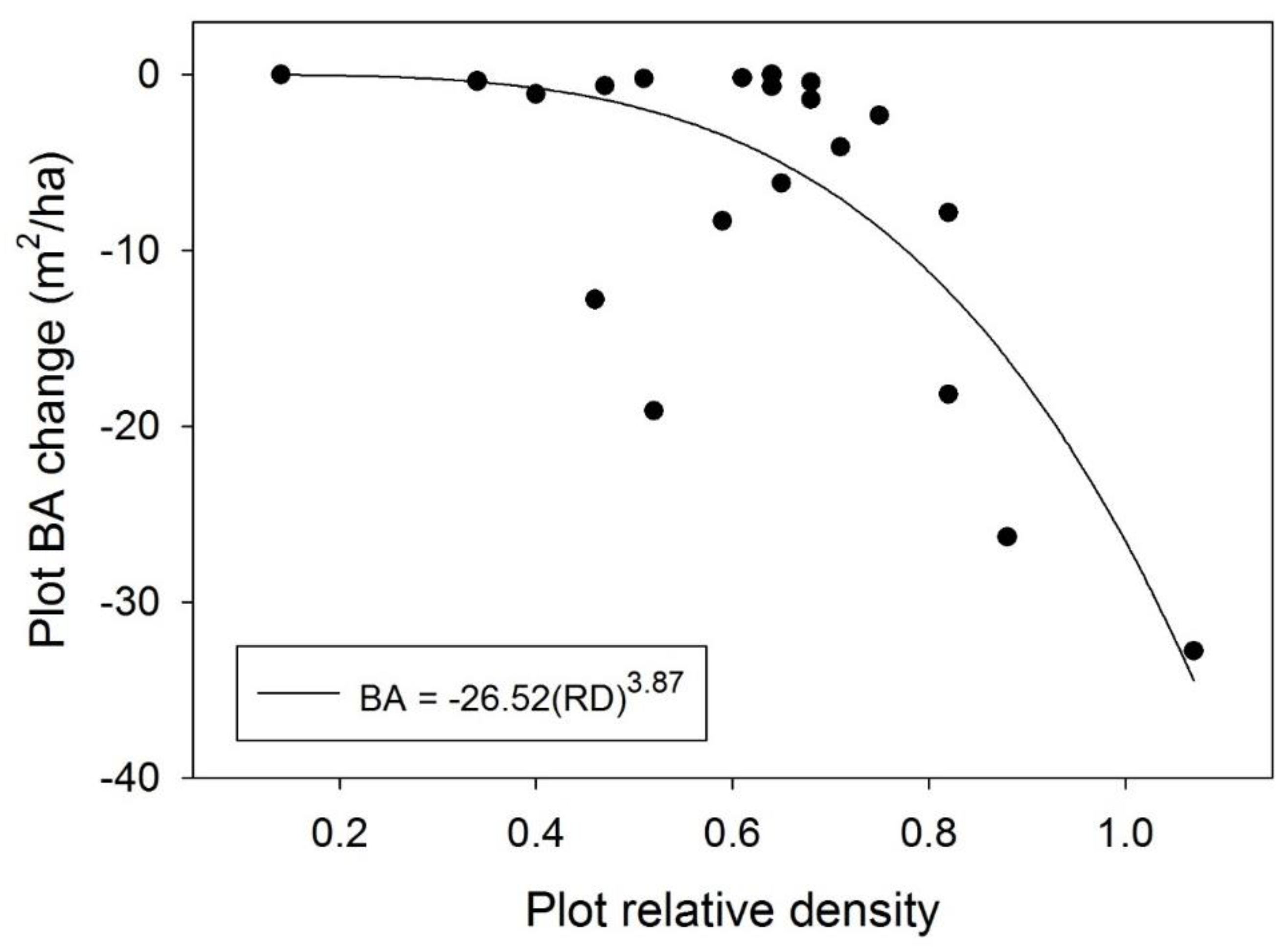
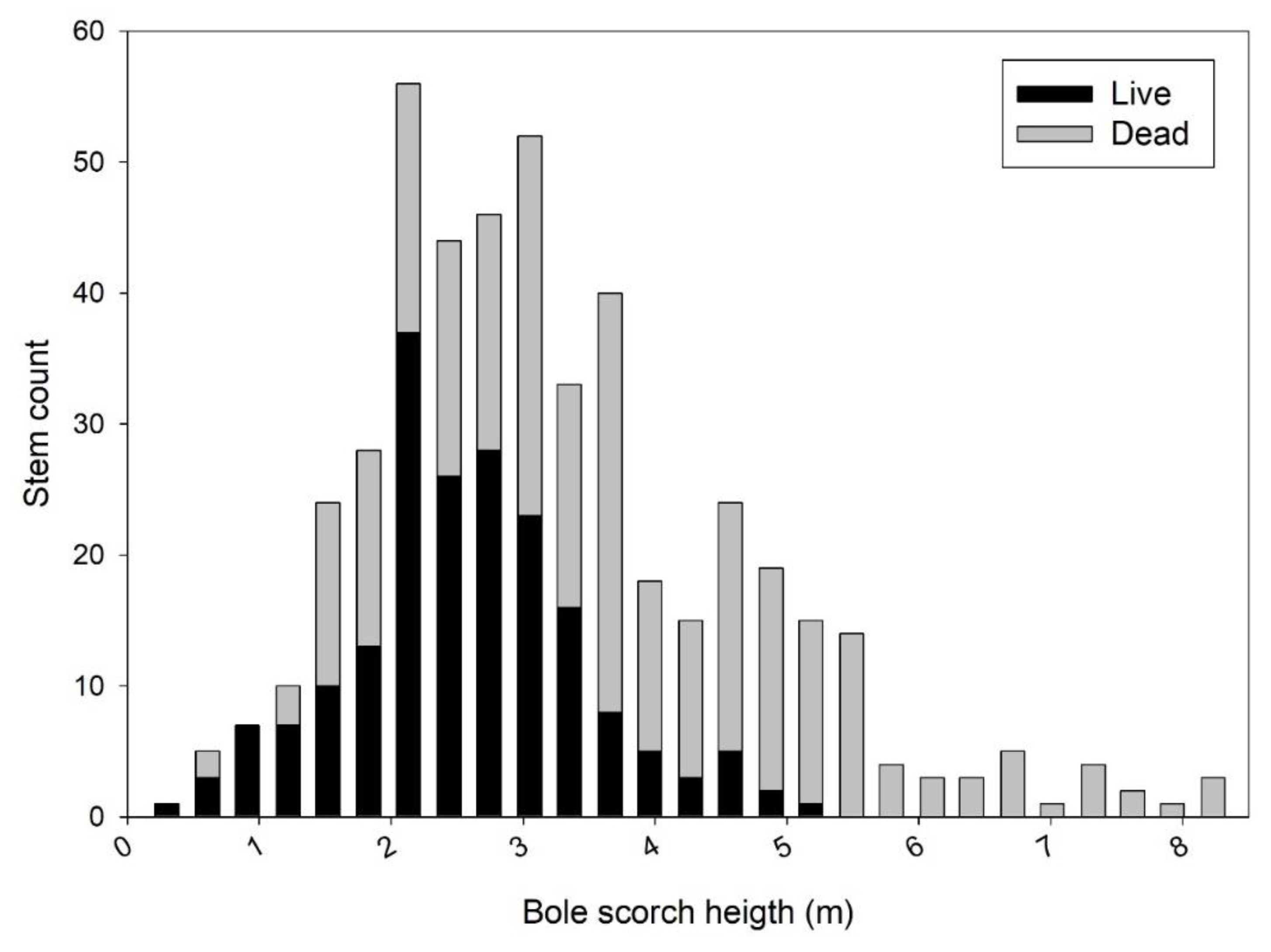
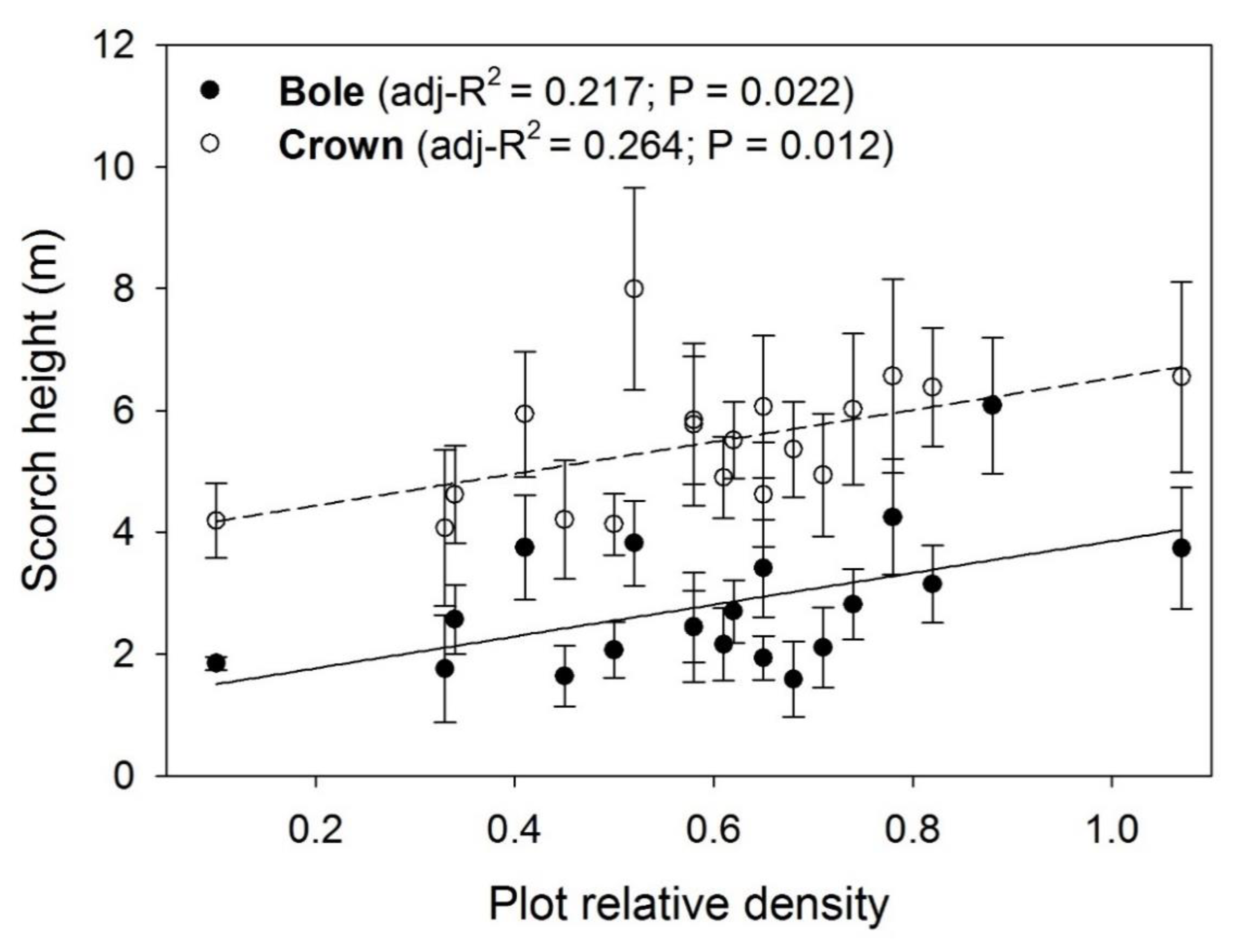
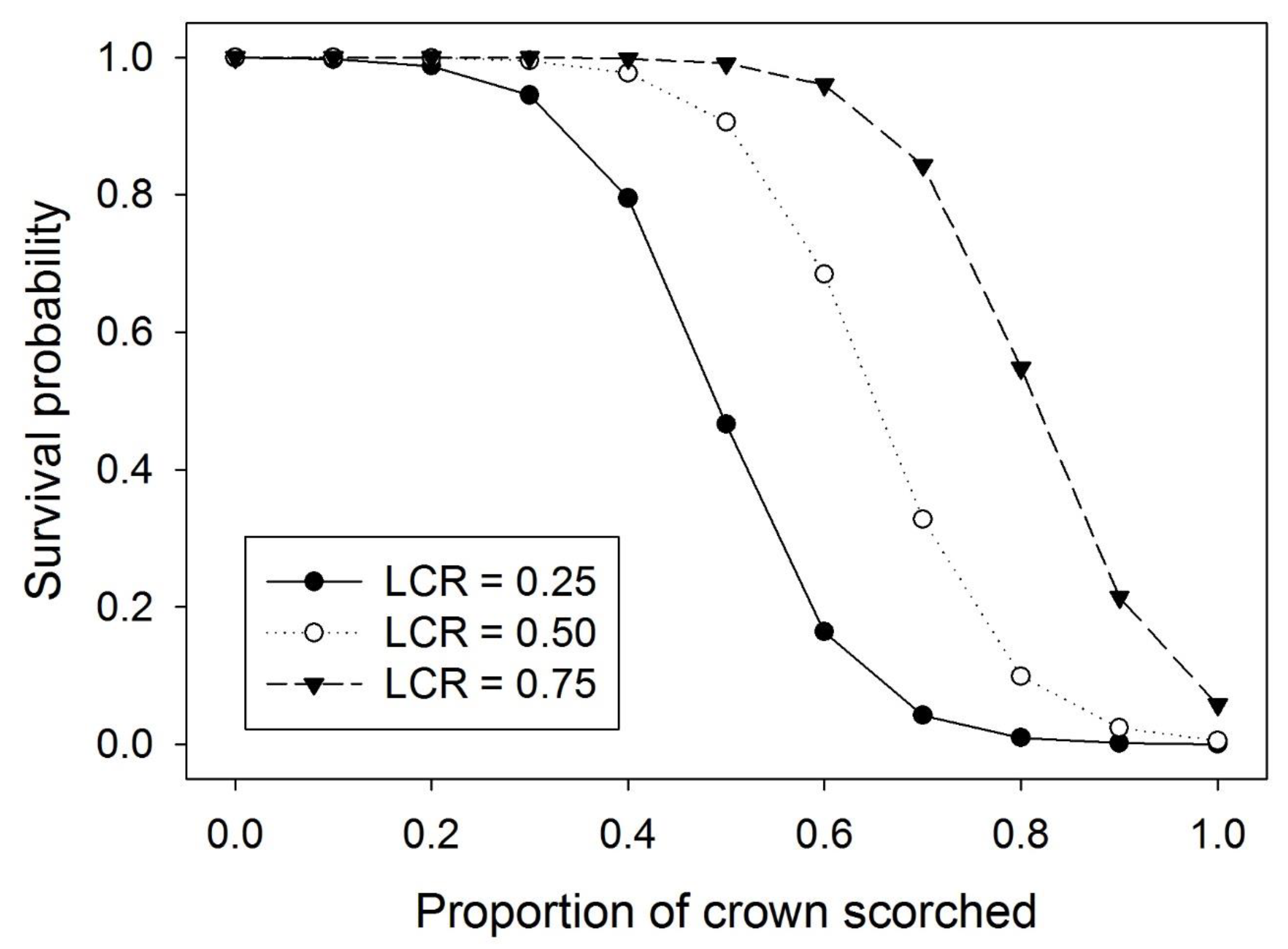
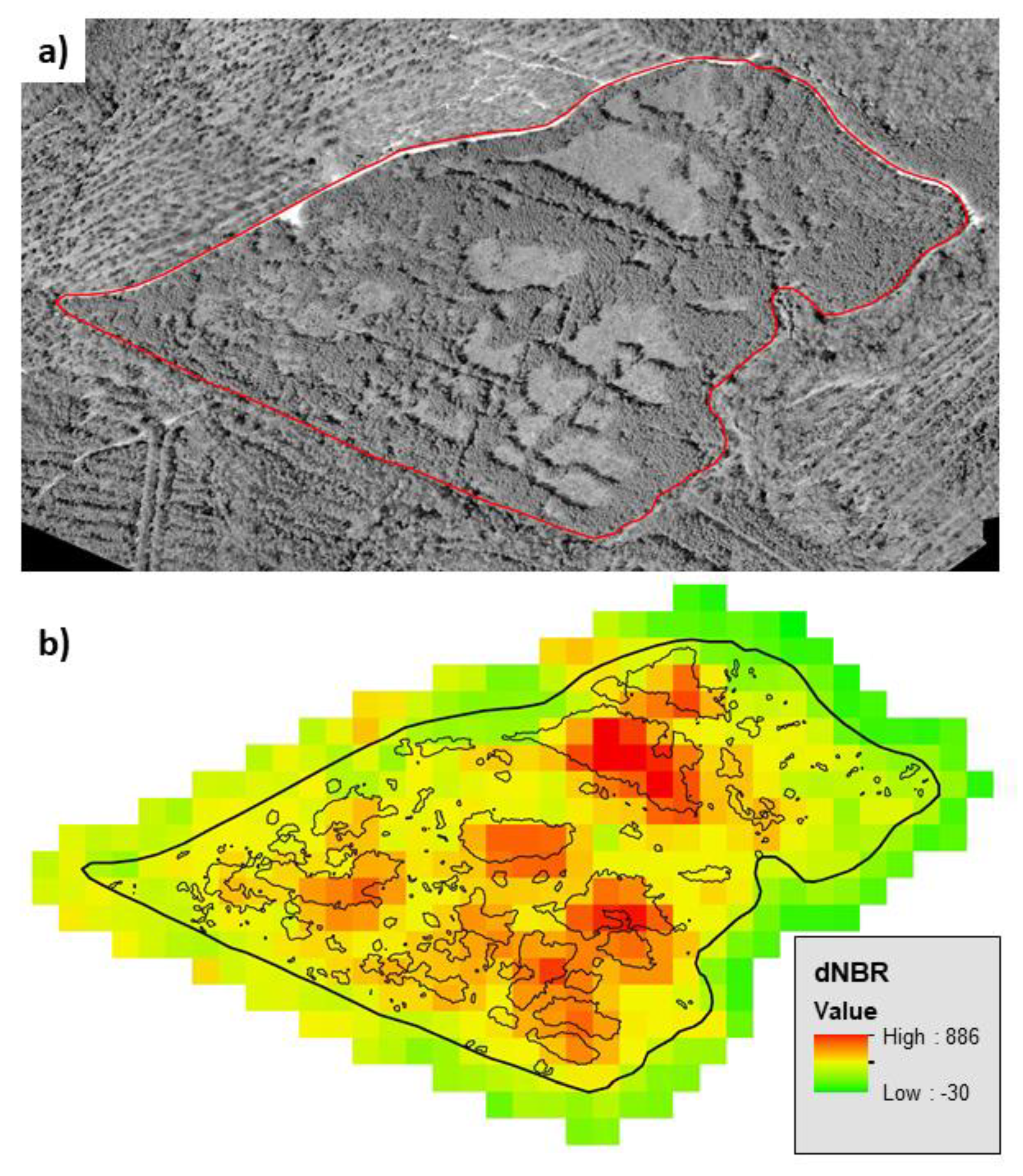
| Stem Density (trees/ha) | Basal Area (m2/ha) | Aboveground Biomass (t/ha) | Pine Stocking | |||||
|---|---|---|---|---|---|---|---|---|
| Date | Pines | Total | Pines | Total | Pines | Total | Dq (cm) | RD |
| May 2011 | 3366 ± 1369 | 3607 ± 1341 | 23.6 ± 3.6 | 23.9 ± 3.5 | 60.4 ± 10.0 | 61.0 ± 9.8 | 10.1 ± 1.2 | 0.60 ± 0.10 |
| Aug 2011 | 1445 ± 363 | 1457 ± 365 | 17.3 ± 4.5 | 17.3 ± 4.4 | 45.1 ± 12.0 | 45.2 ± 12.0 | 11.8 ± 1.6 | 0.43 ± 0.10 |
| Sept 2011 | 1346 ± 369 | 1359 ± 371 | 16.4 ± 4.4 | 16.4 ± 4.4 | 42.9 ± 11.8 | 42.9 ± 11.8 | 12.0 ± 1.6 | 0.40 ± 0.10 |
| July 2012 | 1204 ± 350 | 1204 ± 350 | 16.8 ± 4.9 | 16.8 ± 4.9 | 47.8 ± 14.2 | 47.8 ± 14.2 | 12.9 ± 1.8 | 0.40 ± 0.11 |
| Feb 2014 | 1161 ± 342 | 1161 ± 342 | 17.9 ± 5.5 | 17.9 ± 5.5 | 51.6 ± 15.9 | 51.6 ± 15.9 | 13.5 ± 1.9 | 0.42 ± 0.12 |
| Feb 2015 | 1149 ± 337 | 1297 ± 318 | 19.3 ± 5.9 | 19.5 ± 5.8 | 57.7 ± 18.4 | 58 ± 18.3 | 13.0 ± 1.6 | 0.45 ± 0.12 |
| Feb 2018 | 1040 ± 315 | 1437 ± 204 | 23.3 ± 7.3 | 23.8 ± 7.1 | 74.1 ± 23.7 | 75.1 ± 23.2 | 13.5 ± 2.1 | 0.51 ± 0.14 |
| Model | Equation | β0 | β1 | β2 | β3 | AIC | BIC | Rho2 | Predict | ROC |
|---|---|---|---|---|---|---|---|---|---|---|
| 1 | β0 + β1(RSP) + β2(LCRPRE) + β3(pCS) | 4.916 | −0.014 | 9.608 * | −14.902 *** | 152.8 | 169.4 | 0.779 | 0.920 | 0.981 |
| 2 | β0 + β1(RSP) + β2(LCRPRE) + β3(LCRPOST) | −7.512 ** | −0.317 | 6.318 * | 21.225 *** | 149.8 | 166.5 | 0.784 | 0.922 | 0.980 |
| 3 | β0 + β1(RSP) + β2(LCRPOST) | −3.95 *** | 0.942 | 22.445 *** | na | 153.3 | 165.8 | 0.776 | 0.919 | 0.978 |
| 4 | β0 + β1(RSP) + β2(pBS) | 1.578 * | 7.718 *** | −16.329 *** | na | 260.3 | 272.7 | 0.613 | 0.838 | 0.956 |
| 5 | β0 + β1(LCRPOST) | −3.423 *** | 23.246 *** | na | na | 151.8 | 160.1 | 0.775 | 0.919 | 0.980 |
| 6 | β0 + LCRPRE + LCRPOST | −7.505 ** | 6.050 * | 21.052 *** | na | 147.9 | 160.4 | 0.784 | 0.922 | 0.980 |
| 7 | β0 + β1(BLCPRE) + β2(LCRPOST) | −1.481 * | −0.307 ** | 23.135 *** | na | 147.5 | 160.0 | 0.785 | 0.922 | 0.982 |
| 8 | β0 + β1(LCRPRE) + β2(pCS) | 4.912 | 9.595 * | −14.896 *** | na | 150.8 | 163.3 | 0.779 | 0.920 | 0.981 |
© 2019 by the authors. Licensee MDPI, Basel, Switzerland. This article is an open access article distributed under the terms and conditions of the Creative Commons Attribution (CC BY) license (http://creativecommons.org/licenses/by/4.0/).
Share and Cite
Ray, D.G.; Landau, D. Tree Mortality Following Mixed-Severity Prescribed Fire Dramatically Alters the Structure of a Developing Pinus taeda Forest on the Mid-Atlantic Coastal Plain. Fire 2019, 2, 25. https://doi.org/10.3390/fire2020025
Ray DG, Landau D. Tree Mortality Following Mixed-Severity Prescribed Fire Dramatically Alters the Structure of a Developing Pinus taeda Forest on the Mid-Atlantic Coastal Plain. Fire. 2019; 2(2):25. https://doi.org/10.3390/fire2020025
Chicago/Turabian StyleRay, David G., and Deborah Landau. 2019. "Tree Mortality Following Mixed-Severity Prescribed Fire Dramatically Alters the Structure of a Developing Pinus taeda Forest on the Mid-Atlantic Coastal Plain" Fire 2, no. 2: 25. https://doi.org/10.3390/fire2020025




